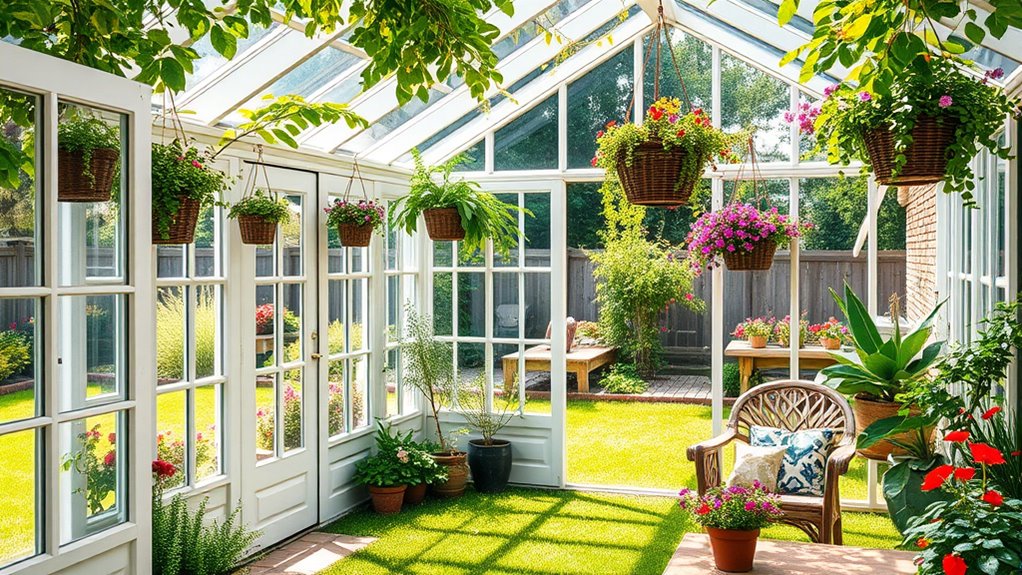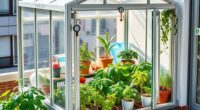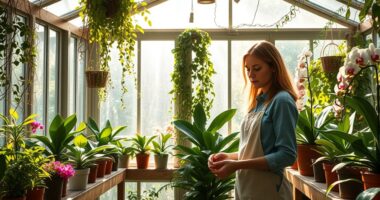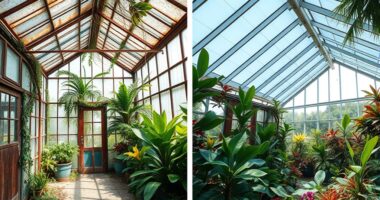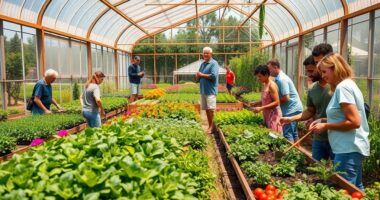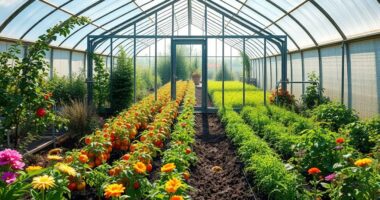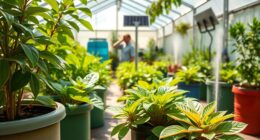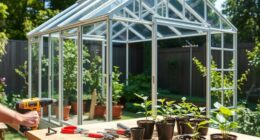Discover inspiring backyard greenhouse ideas that blend beauty, functionality, and sustainability. Consider curved pathways, native plants, and decorative elements like trellises or seating to create a cozy retreat. Use eco-friendly materials such as reclaimed wood and incorporate solar-powered systems or rainwater harvesting to reduce your environmental footprint. Maximize natural light and ventilation to keep your space lively year-round. Keep exploring for more tips to design a stunning, practical greenhouse tailored just for you.
Key Takeaways
- Incorporate curved pathways and native plants for seamless landscape integration and visual harmony.
- Use eco-friendly materials like reclaimed wood and solar-powered systems to enhance sustainability and charm.
- Maximize natural light with skylights and large windows to reduce energy costs and promote plant health.
- Design wide, accessible pathways and within-reach planting beds for ease of maintenance and functionality.
- Add decorative elements such as trellises, hanging planters, or seating areas to create an inviting, relaxing greenhouse retreat.
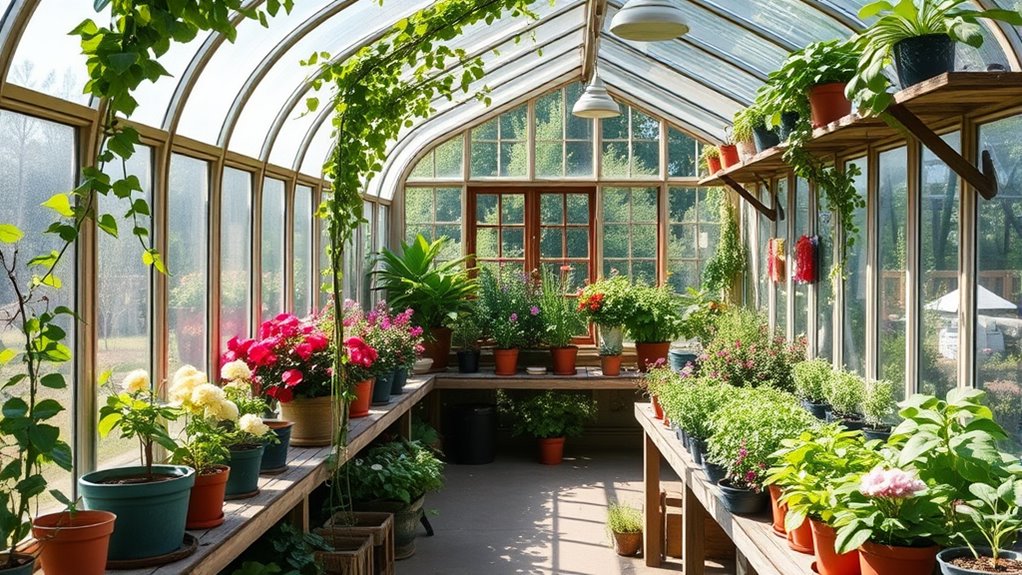
Are you looking to extend your growing season and bring fresh greenery closer to home? A backyard greenhouse is the perfect solution, transforming your outdoor space into a productive oasis. When planning your greenhouse, focus on thoughtful garden design that complements your existing landscape while maximizing functionality. Consider how the structure will fit into your yard, ensuring it doesn’t overpower your space but instead integrates seamlessly. You might want to incorporate curved pathways or strategic plant placements to create a welcoming environment. Opting for sustainable materials not only benefits the planet but can also add a unique charm to your greenhouse. Reclaimed wood, recycled metal, or eco-friendly glazing options can give your structure a stylish yet environmentally conscious appeal. These materials often have a lower environmental impact, and their durability ensures your greenhouse will stand the test of time. When designing your greenhouse, think about the natural light it will receive and how to optimize it. Large, strategically placed windows or skylights can flood the interior with sunlight, reducing the need for artificial lighting and saving energy. Ventilation is equally important, so include adjustable vents or ceiling fans to maintain a healthy environment for your plants. Proper light management ensures your plants thrive and reduces energy costs.
You should also consider the accessibility of your greenhouse, making sure pathways are wide enough for easy movement and that shelves or planting beds are within reach. This not only improves functionality but encourages regular tending of your plants. To keep your greenhouse sustainable, look into rainwater harvesting systems or solar-powered equipment, which can reduce your ecological footprint. The design doesn’t have to be overly complicated; even a simple, well-constructed structure can make a significant difference in your gardening success. Think about integrating native plants or drought-resistant species to further boost sustainability. These choices can reduce water usage and maintenance while supporting local ecosystems.
Additionally, adding a touch of beauty around your greenhouse can inspire you daily. Incorporate decorative elements like trellises, hanging planters, or a small seating area to make the space inviting. Your backyard greenhouse can become more than just a place to grow plants; it can turn into a relaxing retreat and a testament to your dedication to sustainable living. By combining thoughtful garden design with eco-friendly materials, you’ll create a space that’s not only productive but also harmonious with the environment. With proper planning, your greenhouse will become a cherished feature of your backyard, offering fresh produce and lush greenery year-round.
Frequently Asked Questions
How Much Does a Backyard Greenhouse Typically Cost?
A backyard greenhouse typically costs between $500 and $5,000, depending on size, materials, and features. For accurate cost estimation, consider your specific needs and space. Budget planning helps you choose between DIY kits or custom builds, which can notably impact expenses. Keep in mind that larger, more advanced structures with climate control or automatic venting will cost more, so prioritize your must-haves to stay within your budget.
What Are the Best Plants for Small Greenhouses?
You should focus on plant selection that thrives in small greenhouses, like herbs, lettuce, and small peppers. To maximize your space, use vertical gardening and compact containers. Choose plants with similar light and watering needs to simplify care. By optimizing space and selecting the right plants, you create a productive, inviting greenhouse that fits your size constraints and keeps your garden lively and fresh year-round.
How Do I Prevent Pests in My Greenhouse?
Imagine your greenhouse as a delicate sanctuary, shielded from unwelcome intruders. To prevent pests, prioritize pest control by inspecting plants regularly and removing any signs of trouble. Maintain greenhouse hygiene by cleaning tools, pots, and surfaces to keep pests at bay. Use natural deterrents like neem oil, and guarantee proper ventilation. These steps create an inhospitable environment for pests, allowing your plants to thrive in peace.
What Is the Ideal Temperature for Greenhouse Growth?
You should aim to keep your greenhouse temperature between 65-75°F for ideal growth. Use proper greenhouse ventilation to prevent overheating and maintain consistent airflow, which helps regulate temperature. Additionally, control plant humidity levels to avoid excess moisture that can lead to mold or pests. Regular monitoring ensures your plants stay in the perfect temperature range, promoting healthy growth and maximizing your greenhouse’s productivity.
How Much Sunlight Is Needed for a Healthy Greenhouse?
Think of your greenhouse as a sunlit dance floor where plants twirl in the spotlight. You’ll want around 6 to 8 hours of sunlight daily, with ample light intensity to energize growth. Longer sunlight durations boost photosynthesis, creating a lush, vibrant environment. Make sure your greenhouse receives consistent, direct sunlight, especially in the morning, to keep your plants thriving and happy, turning your backyard into a verdant oasis.
Conclusion
With these backyard greenhouse ideas, your outdoor space transforms into a lush oasis, bursting with life and color. Imagine stepping into your personal glass sanctuary, where sunlight dances on vibrant leaves and your favorite blooms flourish in harmony. Let your creativity bloom like a garden in full swing, turning a simple backyard into a magical retreat. With a little inspiration and effort, your greenhouse dreams will blossom into a breathtaking haven you’ll cherish every day.
